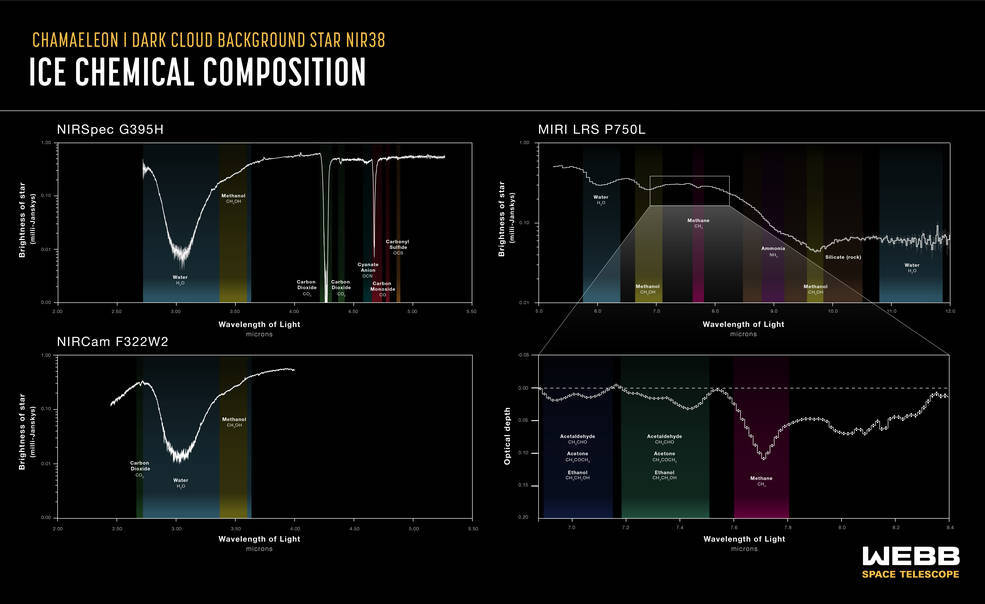By detecting the sulfur-bearing ice carbonyl sulfide, the researchers were able to estimate the amount of sulfur embedded in icy pre-stellar dust grains for the first time. While the amount measured is larger than previously observed, it is still less than the total amount expected to be present in this cloud, based on its density. This is true for the other CHONS elements as well. A key challenge for astronomers is understanding where these elements are hiding: in ices, soot-like materials, or rocks. The amount of CHONS in each type of material determines how much of these elements end up in exoplanet atmospheres and how much in their interiors.
"The fact that we haven't seen all of the CHONS that we expect may indicate that they are locked up in more rocky or sooty materials that we cannot measure,” explained McClure. “This could allow a greater diversity in the bulk composition of terrestrial planets.”
Chemical characterization of the ices was accomplished by studying how starlight from beyond the molecular cloud was absorbed by icy molecules within the cloud at specific infrared wavelengths visible to Webb. This process leaves behind chemical fingerprints known as absorption lines which can be compared with laboratory data to identify which ices (frozen molecules) are present in the molecular cloud. In this study, the team targeted ices buried in a particularly cold, dense, and difficult-to-investigate region of the Chamaeleon I molecular cloud, a region roughly 500 light-years from Earth which is currently in the process of forming dozens of young stars.
“We simply couldn't have observed these ices without Webb,” elaborated Klaus Pontoppidan, Webb project scientist at the Space Telescope Science Institute in Baltimore, Maryland, who was involved in this research. “The ices show up as dips against a continuum of background starlight. In regions that are this cold and dense, much of the light from the background star is blocked, and Webb’s exquisite sensitivity was necessary to detect the starlight and therefore identify the ices in the molecular cloud.”
“This is just the first in a series of spectral snapshots that we will obtain to see how the ices evolve from their initial synthesis to the comet-forming regions of protoplanetary disks,” concluded McClure. “This will tell us which mixture of ices — and therefore which elements — can eventually be delivered to the surfaces of terrestrial exoplanets or incorporated into the atmospheres of giant gas or ice planets.”
These results were published in the Jan. 23 issue of Nature Astronomy.
The two feats almost did not happen.
The most comprehensive plans need a sprinkle of luck, even in space.
In October 2022, the James Webb Space Telescope (JWST or Webb) watched as Chariklo, a tiny ringed asteroid, eclipsed a star. This event, called an occultation, marked a first for Webb. At the month's end, Webb turned toward Chariklo again and notched another victory: For the first time, astronomers analyzing the telescope's data spotted clear signs of water ice, the presence of which was only hinted at until now. These observations will guide astronomers to better understand the nature and behavior of tiny bodies in the outer reaches of our solar system.
But the two feats almost did not happen.
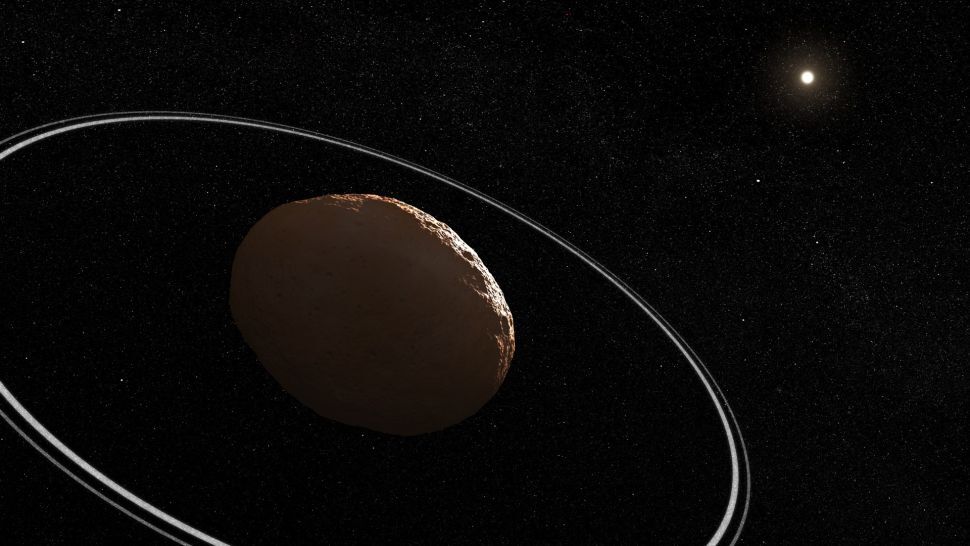
This illustration shows what the Centaur Chariklo and its rings could look like, based on our current understanding. (Image credit: NASA, ESA, CSA, Leah Hustak (STScI))
Although it is the largest of its kind, Chariklo is still too small and too far for even the mighty Webb to photograph directly. Instead, astronomers decided to study it through occultation, which is an indirect but powerful method to study small bodies like Chariklo. But the team did not know if and when a star — without which an occultation would not occur — would fall into Webb's field of view. This made Chariklo part of Webb's target of opportunity(opens in new tab) program: If the asteroid happened to cross in front of a star, the program would allow astronomers to temporarily interrupt the telescope's schedule to observe the event.
The team calculated only a 50% chance that Webb would spot a star bright enough with an interesting object like Chariklo crossing in front. After its launch in 2021, as Webb went through routine course corrections to hold it steady in its parking spot in space, the team continued predicting and revising its list of possible occultations. Late last year, astronomers ended up on the favorable side of that 50% when they discovered "by remarkable good luck" that Chariklo was on track to occult a star that also fell into Webb's view.
"This was the first stellar occultation attempted with Webb," the team wrote in a NASA statement(opens in new tab) published Wednesday (Jan. 25). "A lot of hard work went into identifying and refining the predictions for this unusual event."
On Oct. 18, 2022, Chariklo and its system of two rings crossed in front of a star. Using Webb's near-infrared camera (NIRCam), astronomers monitored the star's brightness for an hour. Resulting data showed two dips in the star's brightness as expected: When the asteroid's rings first hid the star as the eclipse began, and again when the last of its rings wrapped up the occultation.
"The shadows produced by Chariklo's rings were clearly detected," the team wrote in the statement, "demonstrating a new way of using Webb to explore solar system objects."
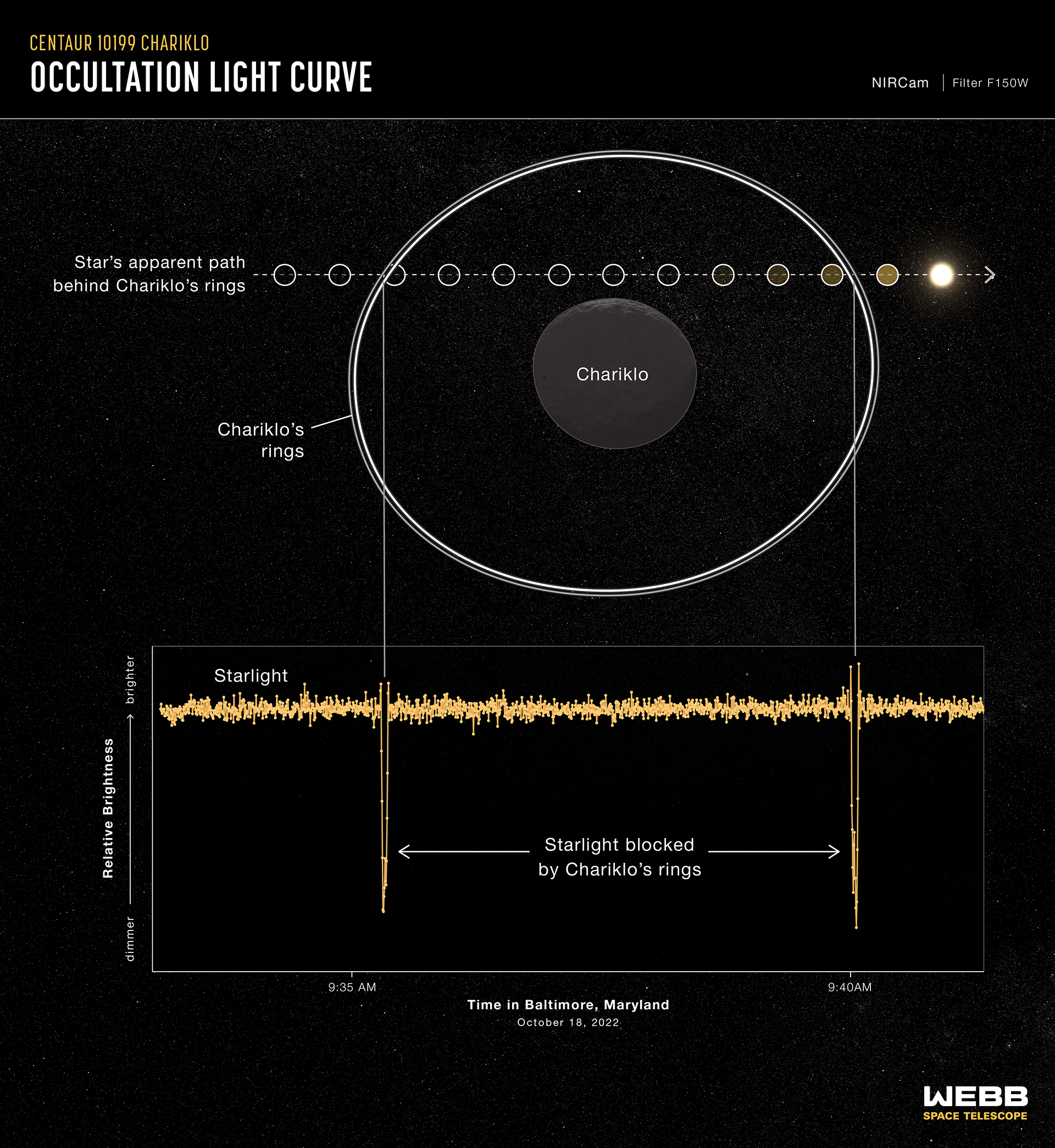
Graphic showing the dimming effects of Chariklo's rings on a background star. (Image credit: IMAGE: NASA, ESA, CSA, Leah Hustak (STScI) SCIENCE: Pablo Santos-Sanz (IAA-CSIC), Nicolás Morales (IAA-CSIC), Bruno Morgado (UFRJ, ON/MCTI, LIneA))
Objects like Chariklo are called centaurs, thanks to their hybrid nature. (Centaurs are mythological horse-human hybrids.) They look like asteroids but behave like comets — complete with visible tails. Their home, an unstable orbit between Jupiter and Neptune, hosts thousands of centaurs of varying shapes and sizes. As interesting as they are, their small size and vast distance make them difficult to study. The composition of even the biggest centaur, Chariklo — which is still tiny at just 160 miles (250 km) in diameter and distant at a whooping 2 billion miles (3.2 billion km) from us — is poorly understood. Also, past research hinted at water ice somewhere in Chariklo's system, but had yet to conclusively detect it.
In this latest research, astronomers pointed Webb at Chariklo again. This time, they used the telescope's Near-infrared Spectrograph (NIRSpec) instrument to measure the sunlight reflected by Chariklo and its two rings. The resulting spectrum showed three absorption bands of water ice, marking the first clear indication of crystalline ice.
The presence of crystalline ice likely indicates that Chariklo is subject to constant bombardment, according to Dean Hines, an astronomer at the Space Telescope Science Institute in Maryland. "Because high-energy particles transform ice from crystalline into amorphous states, detection of crystalline ice indicates that the Chariklo system experiences continuous micro-collisions that either expose pristine material or trigger crystallization processes," Hines said in NASA's statement.

Reflectance spectrum of the double-ringed centaur 10199 Chariklo, captured by Webb's Near-Infrared Spectrograph (NIRSpec) on Oct. 31, 2022. This spectrum shows clear evidence for crystalline water ice on Chariklo's surface. (Image credit: IMAGE: NASA, ESA, CSA, Leah Hustak (STScI) SCIENCE: Noemí Pinilla-Alonso (FSI/UCF), Ian Wong (STScI), Javier Licandro (IAC))
Astronomers have gotten one step closer to studying the Chariklo system, but there is still much that remains unknown about the centaur. The spectrum analyzed in the latest research includes information about the system as a whole, but at the moment, it is difficult to distinguish the data between Chariklo and its two rings.
For example, although astronomers spotted the first clear signs for crystalline water ice, they do not yet know for sure where in the asteroid's system the ice is present. In the coming months, researchers hope to use Webb's high sensitivity to dig up individual features of Chariklo and its two rings, Pablo Santos-Sanz, an astronomer at the Instituto de Astrofísica de Andalucía in Spain who took part in this research, said in the statement.
"We hope [to] gain insight into why this small body even has rings at all, and perhaps detect new fainter rings," Santos-Sanz said.
Quelle: SC
----
Update: 2.02.2023
.
A Spiral Amongst Thousands

A crowded field of galaxies throngs this Picture of the Month from the NASA/ESA/CSA James Webb Space Telescope, along with bright stars crowned with Webb’s signature six-pointed diffraction spikes. The large spiral galaxy at the base of this image is accompanied by a profusion of smaller, more distant galaxies which range from fully-fledged spirals to mere bright smudges. Named LEDA 2046648, it is situated a little over a billion light-years from Earth, in the constellation Hercules.
One of Webb’s principle science goals is to observe distant galaxies in the early universe to understand the details of their formation, evolution, and composition. Webb’s keen infrared vision helps the telescope peer back in time, as the light from these distant galaxies is redshifted towards infrared wavelengths. Comparing these systems with galaxies in the local universe will help astronomers understand how galaxies grew to form the structure we see today. Webb will also probe the chemical composition of thousands of galaxies to shed light on how heavy elements were formed and built up as galaxies evolved.
To take full advantage of Webb’s potential for galaxy archeology, astronomers and engineers must first calibrate the telescope’s instruments and systems. Each of Webb’s instruments contains a labyrinthine array of mirrors and other optical elements that redirect and focus starlight gathered by Webb’s main mirror. This particular observation was part of the commissioning campaign for Webb’s Near-InfraRed Imager and Slitless Spectrograph (NIRISS). As well as performing science in its own right, NIRISS supports parallel observations with Webb’s Near-InfraRed Camera (NIRCam). NIRCam captured this galaxy-studded image while NIRISS was observing the white dwarf WD1657+343, a well-studied star. This allows astronomers to interpret and compare data from the two different instruments, and to characterise the performance of NIRISS.
[Image description: Many stars and galaxies lie on a dark background, in a variety of colours but mostly shades of orange. Some galaxies are large enough to make out spiral arms. Along the bottom of the frame is a large, detailed spiral galaxy seen at an oblique angle, with another galaxy about one-quarter the size just beneath it. Both have a brightly glowing core, and areas of star formation which light up their spiral arms.]
Quelle: ESA
----
Update: 3.02.2023
.
The James Webb Space Telescope gets its own micrometeoroid forecast — here's how
"It is essentially a meteoroid flux detector, although not intentionally."
Even as the James Webb Space Telescope is allowing astronomers to see inside vast, distant galaxies, it's also studying some tiny, nearby objects — albeit inadvertently.
These are micrometeoroids, tiny mysteries zipping through the solar system at lightning speed. They're far too small for scientists to observe directly in deep space, but they shouldn't be ignored: Micrometeoroids can pack quite a punch, as NASA's James Webb Space Telescope (JWST or Webb) can attest. Since JWST's Christmas 2021 launch, engineers have detected more than 20 micrometeoroid impacts to the telescope; only one noticeably hurt the observatory. The mission is adjusting its operations to reduce the frequency of micrometeoroid hits, but still, the impacts themselves are perhaps the least expected data from the powerhouse new observatory.
"It is essentially a meteoroid flux detector, although not intentionally," Margaret Campbell-Brown, a meteor physicist at the University of Western Ontario in Canada, told Space.com. "Although, of course, we're sad for them when their mirror gets hit by meteoroids."
The JWST team briefly worried that it had underestimated the threat from these tiny particles in May 2022, when scientists saw a relatively large micrometeoroid hit on the observatory's massive golden mirror even before normal science observations had begun.
But by the time the observatory marked the first anniversary of its Christmas 2021 launch, the team's confidence had returned: Scientists had determined the worrying micrometeoroid was large enough that they wouldn't expect to encounter such an object more than about once a year, and engineers had determined that the particle managed to hit a particularly vulnerable location.
"For the most part, we've been getting about one to two a month that we can actually detect," Lee Feinberg, optical telescope element manager for JWST at NASA's Goddard Space Flight Center in Maryland, told Space.com of the impacts. "At this point, it's really been a very minor thing."
However, JWST is now targeting perhaps two decades of operations, so the team has decided to play it safe, adapting its observation strategy to limit the amount of time the telescope will be vulnerable to the most energetic impacts. "We want those pictures of the Carina Nebula to look just as beautiful 20 years from now," Feinberg said.
And that means understanding micrometeoroids.
An unusual observatory
JWST is in a unique situation. The $10 billion observatory is perched at what scientists call the Earth-sun Lagrange point 2 (L2), which is about 1 million miles (1.5 million kilometers) away from Earth in the direction opposite the sun. L2 is one of the pockets of the solar system where gravitational tugs balance out, making it a relatively cheap outpost to occupy fuel-wise, and it's perfect for the telescope's high-power infrared optics that need protection from the sun.
But scientists have sent only a few spacecraft to L2, and none of them had the vulnerability of JWST: The telescope's massive mirror is bared to space, and engineers keep an eye on its smoothness to help scientists understand their data. Compare that design with an observatory like the Hubble Space Telescope, which is sheathed by a tube that absorbs impacts with no visible scars.
"We're actually able to monitor this stuff at a level of detail that nobody's ever been able to do before," Feinberg said.
Despite the flurry of concern in May, engineers working on JWST knew all along that micrometeoroids would hit the observatory. "If you put anything out in space long enough, it's gonna get hit by something," Bill Cooke, head of NASA's Meteoroid Environments Office at Marshall Space Flight Center in Alabama, told Space.com. "ISS [the International Space Station], Chandra, Hubble — you name a vehicle that's been up there for years, they've all been hit. Most of the hits are not significant to mission operations, but they do get hit."
Early in the JWST design process, mission personnel simulated micrometeoroid impacts on a mirror, although Feinberg noted that engineers don't have a way of accelerating tiny particles all the way to the speeds they reach in the solar system, so the experiments can't really mimic the power of an impact. Scientists also used the models they had at the time to get a sense of how many hits the observatory might experience during its planned five-year lifespan.
"That's kind of how we dealt with it from the point of view of developing JWST," Feinberg said. "And then, honestly, I don't know that I thought much about micrometeoroids and our mirrors until we were actually in space."
Spotting meteoroids
But while Feinberg and countless colleagues were making JWST a reality, meteor scientists were busy as well, honing their understanding of space around us.
Scientists have determined that only about 10% of micrometeoroids are connected to the meteors we're most familiar with, those in streams that cause specific meteor showers like the Perseids or Leonids. The other 90% of micrometeoroids are what scientists call sporadics, which travel alone, zipping through the solar system on random orbits, which can make them more challenging to understand.
"It's a little more work to observe sporadics than meteor showers, because they're not nicely organized into events," Althea Moorhead, a meteor scientist at NASA Marshall, told Space.com.
(Feinberg said that the JWST team believes the impacts the observatory is detecting have come from sporadics.
Scientists also know what type of bodies micrometeoroids come from: about 90% from comets and 10% from asteroids, either the rare active asteroids or debris from a collision between space rocks. And a micrometeoroid's origin shapes its impact. "Of course it makes a big difference if your spacecraft gets hit by a solid rock as opposed to kind of a fluffy aggregate of little grains," Campbell-Brown said. "One's like being sandblasted, and the other one's like being shot."
Because micrometeoroids are far too small for any telescope to see, they're tricky to study, so scientists have combined three main approaches.
First, scientists can study nearby meteoroids thanks to their interactions with Earth's atmosphere. As each meteoroid travels through the atmosphere, its edges warm and erode, leaving what scientists call an ionization trail, which specially tuned radar systems can detect.
"The little tiny particles themselves are much too small for the radar to see," Campbell-Brown said of the meteoroids. But the trails they leave are much larger. "All of those electrons in the atmosphere have a scattering cross-section the size of an aircraft carrier, so there we can get a really good signal even off of these tiny, tiny little particles."
And these trails offer scientists a trove of data. The observatory Campbell-Brown uses, Canadian Meteor Orbit Radar in Ontario, catches thousands of meteor trails each day, she said, and that's enough information to calculate each object's orbit. "So we get thousands and thousands of meteor orbits every day, which really helps us to build up a picture of where these small particles are coming from," Campbell-Brown said.
Second, scientists can consult data from two key missions. NASA lofted three Pegasus spacecraft during the 1960s and '70s; each sported massive wings designed to catch meteoroids and soared to the altitudes Apollo astronauts would reach. Pegasus was followed in the 1980s by the Long Duration Exposure Facility, which the space shuttle program left in orbit for nearly six years and then returned to Earth, letting scientists directly study meteoroid impact scars.
With just four objects that never left Earth's orbit, the spacecraft data is limited, but still useful. "The vast majority of our data is looking at meteors, but it's nice to have some other form of detection to help us tease out some of the ambiguities," Moorhead said.
Help from computers
But that's basically all scientists have in the way of observations, so the final technique is modeling.
Scientists can use computers to simulate the solar system's smallest debris, both its formation and its path; they can smash asteroids to smithereens, create artificial comets and watch them dribble material through the neighborhood, and test how Jupiter's massive gravity might shape meteors' paths.
These days, the models are powerful enough to include what direction particles are coming from. "Our models have advanced to the point where we can tell you which are the riskiest directions to look, whereas the older models were more smeared out, if you will," Cooke said. That's particularly important information for JWST, since head-on impacts are more energetic and so cause more damage.
Still, figuring out what's going on around JWST is a tricky business, since both sources of direct observation come from Earth's neighborhood and there's no guarantee the two regions are identical when it comes to micrometeoroids.
"The problem we have is that the only meteors that we observe generally are close to the Earth, because you're going to look at them in the Earth's atmosphere or you have some impact on the satellites," Auriane Egal, a science advisor at Planetarium Rio Tinto Alcan in Canada who works on modeling meteor streams, told Space.com.
"You can never say, like, 'I'm sure that at L2 this is what's happening,'" she added. "But you're using the Earth and every impact that has occurred on spacecraft in the past to confirm your theoretical models and your numerical models and use that as a basis to predict what's going to occur elsewhere in the solar system."
And so far, JWST's experiences suggest that scientists have been on track with their estimations of the environment at L2. Still, observatory personnel are tweaking their approach, limiting the amount of time the telescope's mirror can point forward, when it's vulnerable to the most energetic — and therefore most damaging — impacts.
No one expects that micrometeoroids will take top billing as scientists consider JWST's legacy years from now. But it's likely not the last telescope we'll send to L2, nor is it likely to be the last observatory with a bare mirror. It's worth knowing what's happening out there.
Quelle: Space.com.
----
Update: 8.02.2023
.
Webb Detects Extremely Small Main Belt Asteroid
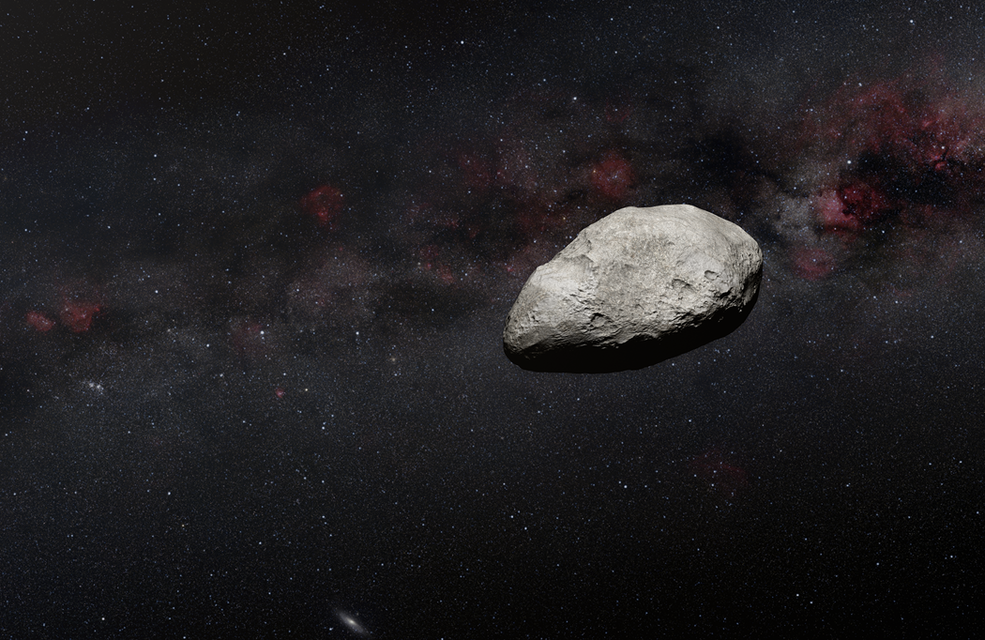
An illustration of an asteroid. The asteroid roughly the size of Rome’s Colosseum — between 300 to 650 feet (100 to 200 meters) in length — has been detected by an international team of European astronomers using NASA's James Webb Space Telescope. They used data from the calibration of the MIRI instrument, in which the team serendipitously detected an interloping asteroid. The object is likely the smallest observed to date by Webb and may be an example of an object measuring under 1 kilometer in length within the main asteroid belt, located between Mars and Jupiter. More observations are needed to better characterize this object’s nature and properties.
Credits: ARTWORK: N. Bartmann (ESA/Webb), ESO/M. Kornmesser and S. Brunier, N. Risinger (skysurvey.org)
An asteroid roughly the size of Rome’s Colosseum — between 300 to 650 feet (100 to 200 meters) in length — has been detected by an international team of European astronomers using NASA’s James Webb Space Telescope. Their project used data from the calibration of the Mid-InfraRed Instrument (MIRI), in which the team serendipitously detected an interloping asteroid. The object is likely the smallest observed to date by Webb and may be an example of an object measuring under 0.6 miles (1 kilometer) in length within the main asteroid belt, located between Mars and Jupiter. More observations are needed to better characterize this object’s nature and properties.
“We — completely unexpectedly — detected a small asteroid in publicly available MIRI calibration observations,” explained Thomas Müller, an astronomer at the Max Planck Institute for Extraterrestrial Physics in Germany. “The measurements are some of the first MIRI measurements targeting the ecliptic plane and our work suggests that many new objects will be detected with this instrument.”
These Webb observations, published in the journal Astronomy and Astrophysics, were not designed to hunt for new asteroids — in fact, they were calibration images of the main belt asteroid (10920) 1998 BC1, which astronomers discovered in 1998. The observations were conducted to test the performance of some of MIRI’s filters, but the calibration team considered them to have failed for technical reasons due to the brightness of the target and an offset telescope pointing. Despite this, the data on asteroid 10920 were used by the team to establish and test a new technique to constrain an object’s orbit and to estimate its size. The validity of the method was demonstrated for asteroid 10920 using the MIRI observations combined with data from ground-based telescopes and ESA’s Gaia mission.
In the course of the analysis of the MIRI data, the team found the smaller interloper in the same field of view. The team’s results suggest the object measures 100–200 meters, occupies a very low-inclination orbit, and was located in the inner main-belt region at the time of the Webb observations.
“Our results show that even ‘failed’ Webb observations can be scientifically useful, if you have the right mindset and a little bit of luck,” elaborated Müller. “Our detection lies in the main asteroid belt, but Webb’s incredible sensitivity made it possible to see this roughly 100-meter object at a distance of more than 100 million kilometers.”
The detection of this asteroid — which the team suspects to be the smallest observed to date by Webb and one of the smallest detected in the main belt — would, if confirmed as a new asteroid discovery, have important implications for our understanding of the formation and evolution of the solar system. Current models predict the occurrence of asteroids down to very small sizes, but small asteroids have been studied in less detail than their larger counterparts owing to the difficulty of observing these objects. Future dedicated Webb observations will allow astronomers to study asteroids smaller than 1 kilometer in size.
What’s more, this result suggests that Webb will also be able to serendipitously contribute to the detection of new asteroids. The team suspects that even short MIRI observations close to the plane of the solar system will always include a few asteroids, most of which will be unknown objects.
In order to confirm that the object detected is a newly discovered asteroid, more position data relative to background stars is required from follow-up studies to constrain the object’s orbit.
“This is a fantastic result which highlights the capabilities of MIRI to serendipitously detect a previously undetectable size of asteroid in the main belt,” concluded Bryan Holler, Webb support scientist at the Space Telescope Science Institute in Baltimore, Maryland. “Repeats of these observations are in the process of being scheduled, and we are fully expecting new asteroid interlopers in those images.”
The James Webb Space Telescope is the world’s premier space science observatory. Webb will solve mysteries in our solar system, look beyond to distant worlds around other stars, and probe the mysterious structures and origins of our universe and our place in it. Webb is an international program led by NASA with its partners, ESA (European Space Agency) and the Canadian Space Agency.
Quelle: NASA
----
Update: 9.02.2023
.
James Webb Space Telescope reveals stellar 'clumps' from the most distant universe
With a little help from nature, the James Webb Space Telescope reveals clumps of stars nearly as old as the universe itself.
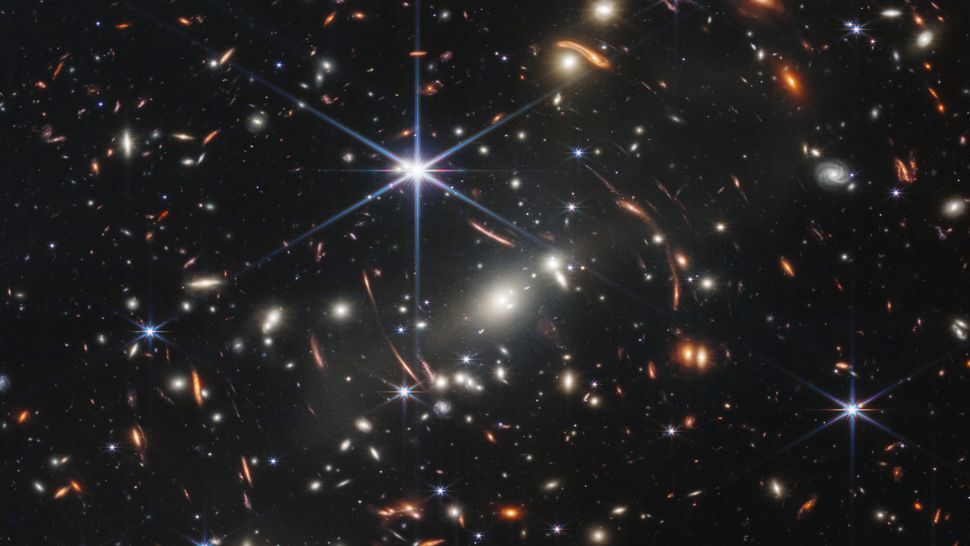
Astronomers found ancient clumps of stars in an iconic image by the James Webb Space Telescope. (Image credit: NASA/ESA/STScI/CSA)
Through the combined powers of NASA's James Webb Space Telescope and nature's own magnifying tool, gravitational lenses, astronomers can observe the earliest stages of galaxy formation in a time when the universe was less than 1 billion years old.
Gravitational lensing is an effect caused by the bending of light in the vicinity of extremely massive objects, such as black holes or, in this case, enormous clusters of galaxies. Taking advantage of the magnifying effect of the galaxy cluster SMACS 0723, which is 4.6 billion light-years away from Earth, scientists were able to view even more distant galaxies in the cluster's background.
The image of the SMACS 0723 cluster used in this study may look familiar to you as it was one of the first images obtained by the James Webb Space Telescope to be released to the public last July. Dubbed Webb's first deep field, the image reveals several of these lensed, background galaxies, the oldest of which is more than 13 billion years old. Astronomers estimate that this galaxy formed only about 680 million years after the Big Bang.
In and around those ancient galaxies, astronomers found clumps of stars, a sort of galactic embryos, which represent the earliest stages of galaxy formation and reveal how galaxies evolved and grew in the first hundreds of millions of years after the universe's birth.
"The images from the James Webb Space Telescope show that we can now detect very small structures inside very distant galaxies and that we can see these clumps in many of these galaxies," Angela Adamo, an astronomer at Stockholm University in Sweden and one of the lead authors of the study, said in a statement(opens in new tab). "The telescope is a game-changer for the entire field of research and helps us understand how galaxies form and evolve."
The researchers added in the statement that studying such distant stellar clumps was impossible before.
The study(opens in new tab) was published in the journal Monthly Notices of the Royal Astronomical Society last month.
Quelle: SC
----
Update: 10.02.2023
.
James Webb Space Telescope pushed past its limits to observe DART asteroid crash
The grand telescope was not built to track very fast moving objects, but it managed nonetheless.
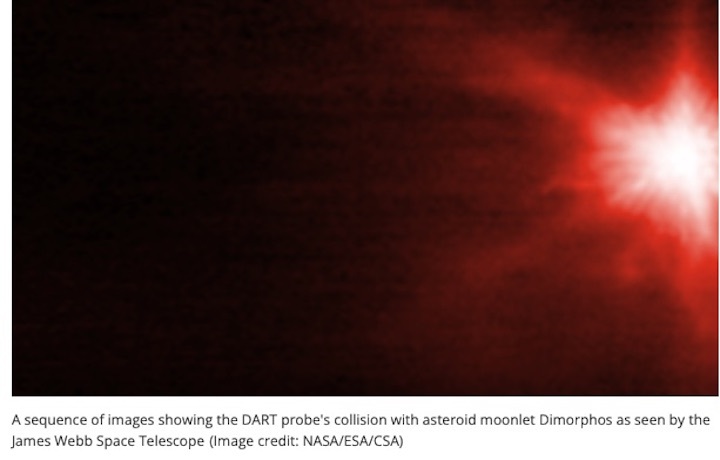
The James Webb Space Telescope had to perform outside of its design limits to observe the collision of NASA's DART probe with the asteroid moonlet Dimorphos in September last year, NASA has revealed.
Writing in a blog post, NASA's James Webb Space Telescope deputy project scientist Stefanie Milam, of the Goddard Space Flight Center in Maryland, revealed that scientists had to go to great lengths to enable the grand telescope to watch the historic space rock deflection test.
On September 26, 2023, after a ten-month journey in space, the 1,260-pound (570 kilograms) Double Asteroid Redirection Test (DART) probe smashed into the 620-foot-wide (190 meters) asteroid moonlet Dimorphos to change its orbit around a larger rock called Didymos. The experiment was the first of its kind, designed to prove that humans could alter the trajectory of an asteroid if one was to threaten our planet in the future. The impact and its aftermath were observed by countless telescopes from Earth as well as in space, and Webb simply couldn't skip the party.
Built primarily to observe the most distant objects in the universe, Webb was, prior to its launch, tested to follow only rather slow moving objects, Milam wrote in the blog post(opens in new tab). The fastest-moving body astronomers expected to track with Webb was Mars, which saunters across the sky at a speed of about 30 milliarcseconds per second (an arcsecond is 1/60 of an arc minute, which is 1/60 of a degree). That means that Mars crosses the width of a full moon as observed from Earth in about 17 hours.
But the near-Earth Didymos/Dimorphos asteroid duo was only about 6.8 million miles (11 million kilometers) from our planet during the DART impact, 24 times closer than the average Mars-Earth distance. And therefore, it appeared to hurtle across the sky much faster. At more than 100 milliarcseconds per second, DART traveled at more than three times Webb's designed tracking speed and that was certain to pose a challenge.
Webb uses its Fine Guidance Sensor (FGS) to track moving objects it wants to image. FGS is a special camera that can lock onto reference stars, also called guide stars, to stay focused on a target with respect to its surroundings. When objects move too fast for Webb, the guidance sensor has to skip from one guide star to another to maintain the target in focus, which is technically demanding. Fortunately, it wasn't necessary to image Dimorphos for a long period of time during the DART impact.
Prior to the planned collision, the Webb team practiced high-speed tracking on a couple of other near-Earth asteroids, including the space rock 2010 DF1, which at 90 milliarcseconds per second was moving in the sky nearly as fast as Dimorphos.
"If we could successfully track this asteroid, we knew we could track the DART impact event," Milam wrote in the blogpost. "We were down to the wire with tests being done only two weeks prior to the date of the DART impact into Dimorphos!"
Thanks to all these preparations, Webb's Near-Infrared Camera (NIRCam) managed to capture an exquisite sequence of images capturing the DART impact and its aftermath, which revealed how material from the tiny asteroid moonlet spread into the surrounding space like an enormous plume.
The observations will help astronomers understand what Dimorphos is made of and how to optimize a possible future asteroid deflection operation if one is ever needed.
Webb wasn't the only space telescope observing the first-of-a-kind experiment. The older Hubble chipped in too. And DART, in fact, traveled to the Didymos/Dimorphos binary asteroid in the company of a personal photographer; the Italy-built LICIACube, captured images of the impact aftermath from a cosmically short distance of only 600 miles (1,000 kilometers).
As for Webb, the DART imaging campaign enabled astronomers to increase the telescope's tracking speed limit to 75 milliarcseconds per second. The team might consider faster observations on a case by case basis.
Quelle: SC
+++
James Webb Space Telescope snaps first ever images of star-forming clusters inside distant galaxies
Studying ancient stellar clumps gives us new insights into galaxy formation.
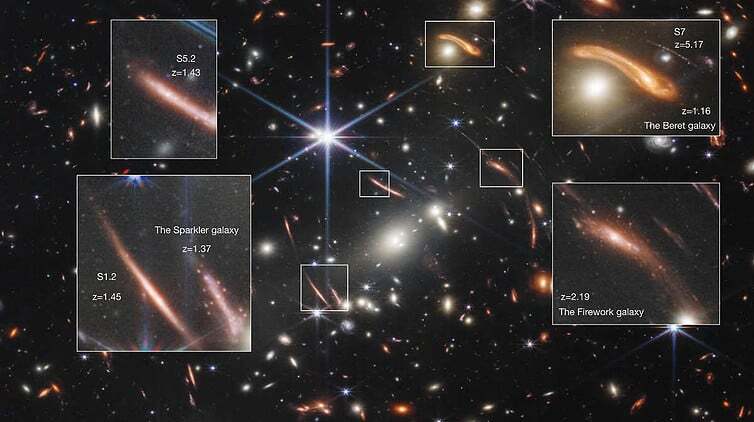
The James Webb Space Telescope captured this image of a galaxy cluster (SMACS0723). The five zoomed in galaxies are so far away that we observe them as they were when the Universe was between one and five billion years old. Today the Universe is 13.7 billion years old. Credit: Image adapted from image release by NASA, ESA, CSA, STScI.
The James Webb Space Telescope (JWST) has provided the first glimpse of very compact structures of star clusters in distant galaxies. The so-called clumps were studied in JWST’s first images of galaxy clusters.
These images have allowed researchers to study the first phase of star formation in the galaxies.
They were aided in their analysis by gravitational lensing – an effect whereby massive objects like galaxies, bend light coming from behind them, causing a zoom-in effect which helps astronomers see distant objects more clearly.
“The galaxy clusters we examined are so massive that they bend light rays passing through their centre, as predicted by Einstein in 1915. And this in turn produces a kind of magnifying glass effect: the images of background galaxies are magnified,” explains Adélaïde Claeyssens, a postdoc at Stockholm University.
Add to the gravitational lensing JWST’s superior resolution and the astronomers were able to detect very compact galaxy structures. The team was able to glean new insights into the links between clump formation and the evolution and growth of galaxies in a way that was not possible before.
The light from the furthest of the galaxies studied has taken 13 billion years to reach Earth, so we are seeing the galaxy as it was when the Universe itself was only 680 million years old.
But Webb has allowed astronomers to see even further into the past.
Late last year, it broke its own record, finding the oldest confirmed galaxy. It existed only 325 million years after the Big Bang.
“The images from the James Webb Space Telescope show that we can now detect very small structures inside very distant galaxies and that we can see these clumps in many of these galaxies. The telescope is a game-changer for the entire field of research and helps us understand how galaxies form and evolve,” says Assistant Professor Angela Adamo, also from Stockholm University.
The research is published in Monthly Notices of the Royal Astronomical Society.
Quelle: COSMOS
----
The James Webb Space Telescope catches distant young galaxy devouring its neighbors
The Sparkler galaxy is feasting its neighbors just as our own galaxy once did.
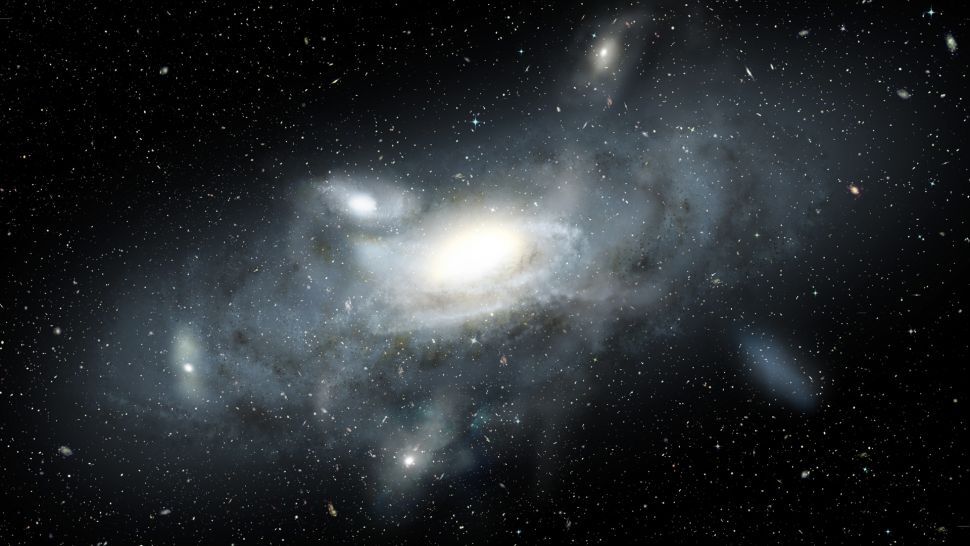
An artist's impression of the Milky Way galaxy in its early days, surrounded by satellite galaxies that are falling into it. (Image credit: James Josephides, Swinburne University
Observations of the tiny Sparkler dwarf galaxy have revealed it sits embedded in a system of ancient star clusters and is greedily feasting on its smaller galactic companions to grow.
This means the galaxy, which was discovered in the first data from the James Webb Space Telescope (JWST), resembles the early cannibalistic Milky Way which also grew by feeding on smaller galaxies. Thus, the investigation of this galaxy provides astronomers with a unique insight into how the Milky Way has evolved.
The Sparkler, located in the southern constellation Volens, was given its name because it is surrounded by around two dozen shining globular clusters, tight groupings of ancient stars. Each of these clusters could contain around a million stars. Our galaxy currently hosts around 200 globular clusters of its own.
The team, led by Swinburne University professor Duncan Forbes, and San Jose State University professor Aaron Romanowsky, examined the age of Sparkler and its surroundings looking at the abundance of elements heavier than hydrogen and helium. Astronomers call these heavy elements "metals."
Looking at the galaxy's surrounding compact star clusters they realized they look like younger versions of the clusters around the Milky Way. Many are metal-rich, similar to globular clusters in the central bulge of our galaxy. The researchers also observed metal-poor intermediate-age clusters that are associated with a satellite galaxy that Sparkler is gobbling up, with its globular clusters acting as a desert.
The Sparkler galaxy is currently just 3% the mass of our galaxy, but the researchers expect it to grow via this feeding process over cosmic timescales to eventually match the mass of the Milky Way as we see it today.
"We appear to be witnessing, first hand, the assembly of this galaxy as it builds up its mass — in the form of a dwarf galaxy and several globular clusters," Forbes said in a statement(opens in new tab). "We are excited by this unique opportunity to study both the formation of globular clusters and an infant Milky Way, at a time when the Universe was only 1/3 of its present age."
Looking back in time with a little help from Einstein
The Sparkler galaxy is located 9 billion light-years from Earth meaning astronomers are seeing as it was around 4 billion years after the Big Bang. The observations are possible because of the impressive infrared observing power of the JWST and a phenomenon first predicted by Albert Einstein back in 1915.
The great physicist's theory of general relativity suggests that objects with great mass "warp" the fabric of space like a heavy ball placed on a stretched rubber sheet. Just as with that simple analogy, the greater the mass, the more extreme the curve it causes.
That means extremely massive objects like black holes or galaxies can "dent" space enough to warp light as it passes them. As a result, if light from a background object passes this warp its travel time is affected. This can lead to that background object being amplified by this foreground landing object, which is described as a "gravitational lens."
The Sparkler galaxy is brightened by just such a gravitational lens which allows the JWST to spot its light which has been traveling for 9 billion years to reach the powerful space telescope.
The team will continue to study globular clusters around Sparkler to learn more about this distant, early galaxy, and in turn our own galaxy, the Milky Way, and its evolution.
"The origin of globular clusters is a long-standing mystery, and we are thrilled that JWST can look back in time to see them in their youth," Romanowsky said.
Quelle: SC

